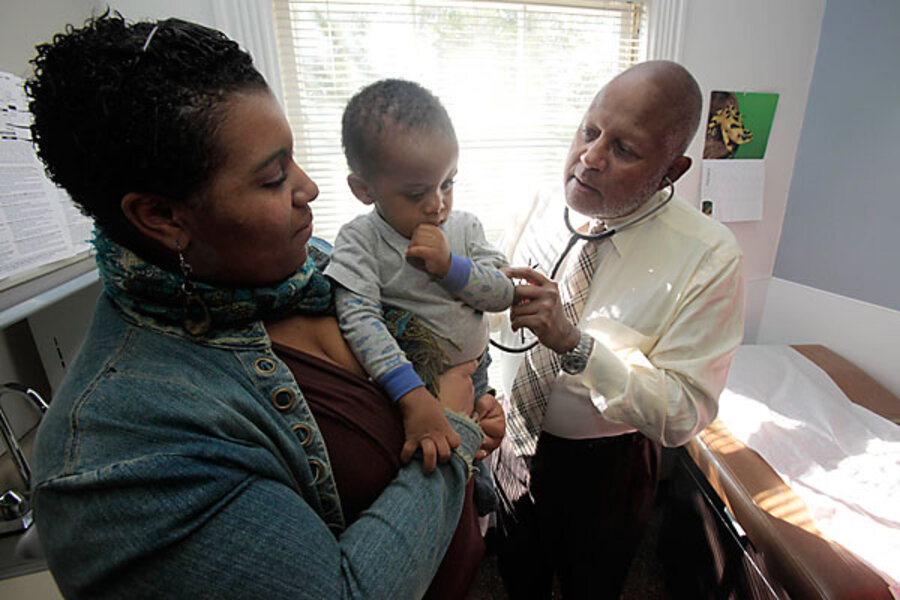Health care reform bill 101: Who gets subsidized insurance?
| Washington
What’s in the healthcare bill? An individual mandate, for one thing.
Yes, the legislation now in Congress would require most people in the US to buy health insurance. That’s the main way it would expand coverage by upward of 32 million people.
We told you about that in the first installment of our attempt to describe bill provisions in plain English. (Our next installments cover the timetable for rolling out reforms, how they would be paid for, and what they mean for businesses.)
Healthcare 101: What the bill means to you
But there’s a carrot that goes along with this stick: subsidies. Uncle Sam would help many lower- and middle-income Americans purchase their health coverage.
What's the formula for aid?
Let’s start with people who are unemployed, self-employed, or work for businesses that don’t offer insurance. Beginning in 2014 (that’s right, this is four years away), these people would be able to shop for coverage in new “health exchanges,” a sort of online bazaar in which insurers would hawk different kinds of plans. We’ll talk more about how these malls might work in our next story.
Congressional budget experts figure that about 25 million people will shop for coverage in these exchanges. That’s a pretty big market. Of these, about 19 million are likely to be eligible for financial aid.
The cutoff level would be an income of four times the federal poverty level. For one person, that’s about $44,000 a year. For a family of four, the comparable figure is about $88,000.
Subsidies would be figured on a sliding scale, with those who make less getting a bigger boost and those nearer the top getting a smaller one.
The formula is pretty complicated. Basically, though, people who make three or four times the poverty level would get enough federal money so that they would not have to pay more than about 10 percent of their income for a decent health insurance package.
People who make less would have to pay a smaller slice of their income for coverage. For instance, individuals who make about $14,000, and four-person families with incomes of about $29,000, would not have to pay more than 3 to 4 percent of their incomes for insurance.
And those who make even less – under 133 percent of the federal poverty level – would be able to enroll in a newly expanded Medicaid program.
The federal subsidy would go straight to the insurer. It would look like a discount on the policy to the customer.
Anyone else who qualifies?
But what if you work for an employer who does offer health insurance? You’re not shopping for policies on the individual market. At least, not yet. Can you still get a subsidy?
Excellent questions. Glad you asked.
Yes, if you make less money than the poverty cutoff level, you would still be eligible for aid. The federal government will in essence guarantee that you do not have to pay more than 9.8 percent of your income for your share of health insurance costs.
There’s something of a catch there, however. The main way the feds would ensure this is to steer you, too, into this new exchange. Your employer would give you a voucher equal to the amount of money it contributes to your policy. Then you’d dive in there and shop for plans with all the self-employed people.
(Unsurprisingly, the Congressional Budget Office numbers indicate it does not expect that many people will do this. Only about 1 million.)
The Department of Health and Human Services would be the umpire making calls as to who would and would not get subsidies. The bill, if enacted, would set up a process for appealing HHS decisions.
We’re thinking the bill, if enacted, also would make HHS one very busy place.
Join the healthcare reform discussion on Facebook
Health Care Reform Bill 101:
Introduction: What the bill means to you
Part 1: Who must buy insurance?
Part 2: Who gets subsidized insurance?
Part 3: What's a health 'exchange'?
Part 4: How long will reform take?
Part 5: Who will pay for reform?
Part 6: What will it mean for business?
Part 7: What does it mean for kids and families?
Part 8: What does it mean for seniors?
Part 9: Rules for preexisting conditions





